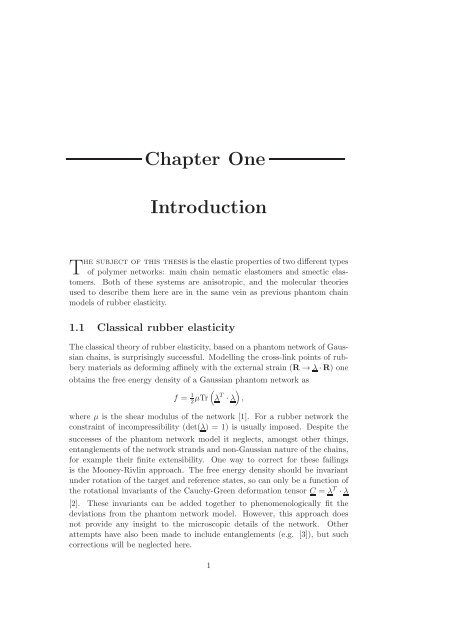Statistical models of elasticity in main chain and smectic liquid ...
Statistical models of elasticity in main chain and smectic liquid ...
Statistical models of elasticity in main chain and smectic liquid ...
Create successful ePaper yourself
Turn your PDF publications into a flip-book with our unique Google optimized e-Paper software.
Chapter OneIntroductionThe subject <strong>of</strong> this thesisistheelastic properties<strong>of</strong> twodifferenttypes<strong>of</strong> polymer networks: ma<strong>in</strong> cha<strong>in</strong> nematic elastomers <strong>and</strong> <strong>smectic</strong> elastomers.Both <strong>of</strong> these systems are anisotropic, <strong>and</strong> the molecular theoriesused to describe them here are <strong>in</strong> the same ve<strong>in</strong> as previous phantom cha<strong>in</strong><strong>models</strong> <strong>of</strong> rubber <strong>elasticity</strong>.1.1 Classical rubber <strong>elasticity</strong>Theclassical theory <strong>of</strong> rubber<strong>elasticity</strong>, based on a phantom network <strong>of</strong> Gaussiancha<strong>in</strong>s, is surpris<strong>in</strong>gly successful. Modell<strong>in</strong>g the cross-l<strong>in</strong>k po<strong>in</strong>ts <strong>of</strong> rubberymaterials as deform<strong>in</strong>g aff<strong>in</strong>ely with the external stra<strong>in</strong> (R → λ·R) oneobta<strong>in</strong>s the free energy density <strong>of</strong> a Gaussian phantom network as)f = 1 2(λ µTr T ·λ ,where µ is the shear modulus <strong>of</strong> the network [1]. For a rubber network theconstra<strong>in</strong>t <strong>of</strong> <strong>in</strong>compressibility (det(λ) = 1) is usually imposed. Despite thesuccesses <strong>of</strong> the phantom network model it neglects, amongst other th<strong>in</strong>gs,entanglements <strong>of</strong> the network str<strong>and</strong>s <strong>and</strong> non-Gaussian nature <strong>of</strong> the cha<strong>in</strong>s,for example their f<strong>in</strong>ite extensibility. One way to correct for these fail<strong>in</strong>gsis the Mooney-Rivl<strong>in</strong> approach. The free energy density should be <strong>in</strong>variantunder rotation <strong>of</strong> the target <strong>and</strong> reference states, so can only be a function <strong>of</strong>the rotational <strong>in</strong>variants <strong>of</strong> the Cauchy-Green deformation tensor C = λ T ·λ[2]. These <strong>in</strong>variants can be added together to phenomenologically fit thedeviations from the phantom network model. However, this approach doesnot provide any <strong>in</strong>sight to the microscopic details <strong>of</strong> the network. Otherattempts have also been made to <strong>in</strong>clude entanglements (e.g. [3]), but suchcorrections will be neglected here.1
















